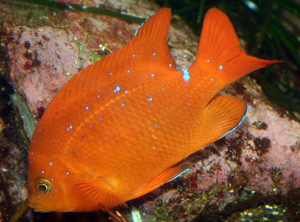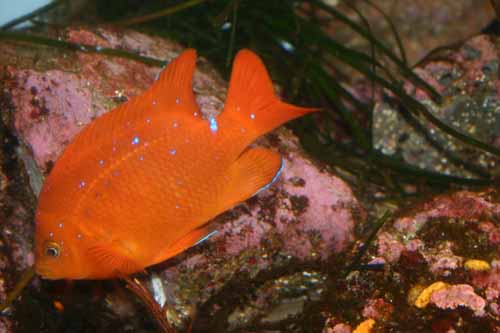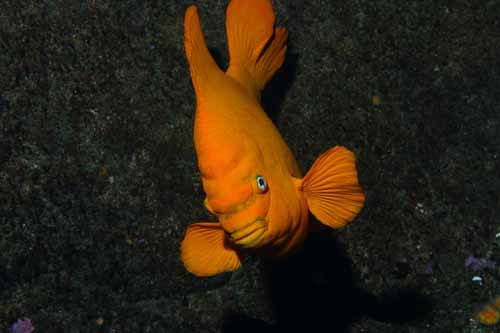
Garibaldi
Hypsypops rubicundus
Overview
Key Features:
Adult is solid orange, laterally compressed, and perch-like in appearance. Juveniles have brilliant iridescent blue spots on body and lines along fins.Primary Common Name:
GaribaldiSynonymous name(s):
Glyphisodon rubicundusGeneral Grouping:
Bony fishesGeographic Range:
Central California to Bahia Magdalena, Baja California, Mexico
Hypsypops rubicundus can be found from Monterey Bay, California to Bahia Magdalena, Baja California, Mexico. It can also be found at Guadalupe Island.Intertidal Height:
0 to 0 feet (0 to 0 meters)Subtidal Depth Range:
Minimum Depth: 0 meters or 0 feetMaximum Depth: 30 meters or 99.9 feet
Habitats:
bay (rocky shore), exposed rocky shore, kelp forest, protected rocky shoreNotes:
Hypsypops rubicundus usually lives over rocky bottoms and in clear water. They can be found occupying reefs and kelp beds near crevices and small caves in the upper 30 meters of the water column.Abundance:
Relative Abundance:
Hypsypops rubicundus is most common in southern California and is rare north of Point Conception, California.Species Description:
General:
Hypsypops rubicundus is a common and obvious fish with its bright orange color distinguishing it from all other fish in the area. It is a member of the Damselfish family, family Pomacentridae in the Order Perciformes, the perch-like fishes. The genus name, Hypsypops, comes from three Greek words and is translated as high below the eye, referring to the wide distance from the front of the head to the eye. The species name, rubicunda is Latin for red.Distinctive Features:
Hypsypops rubicundus has a deep, compressed, perch-shaped body with large scales. The adult is entirely bright golden orange or yellow-orange. Hypsypops rubicundus has a steep head, small mouth, large lips, and yellow eyes. The dorsal fins are joined and extend from above the pectoral fin insertion to posterior of the anal fin base, and the second one is higher. The tail fin is forked and the tips of both lobes are rounded. The dorsal fin has 11 – 13 spines and 12 – 15 rays. The lateral line ends under the soft dorsal fin. The juvenile is reddish orange to brick red, with iridescent blue spots and blotches on its head, body and fins, and its eyes are green. These blue markings gradually disappear with age and may be present in individuals up to 15 cm.Size:
Hypsypops rubicundus can grow to 36 cm.Natural History:
General:
Hypsypops rubicundus is a remarkably territorial fish. Both males and females defend large home territories against each other and other intruders. Even larger fish, from which Hypsypops rubicundus should flee, will be chased away. When fish are disturbed, they emit a clacking sound that is produced by rubbing their throat teeth together. Young Hypsypops rubicundus are rarely harassed by adults and this may be due to their blue markings which apparently give them some protection. Hypsypops rubicundus normally propels itself with its pectoral fins. These fish can live to about 20 years of age. This species is protected by law in California and may not be taken for sport or commercial purposes.Predator(s):
Harbor seals, Phoca vitulina, and bald eagles, Haliaeetus leucocephalus prey on Hypsypops rubicundus.Prey:
Hypsypops rubicundus feeds on a variety of invertebrates, but most often on attached, sessile organisms, such as sponges, cnidarians and bryozoans. They may occasionally eat algae, worms, nudibranchs and small crustaceans.Feeding Behavior:
OmnivoreNotes:
Hypsypops rubicundus feeds during daylight hours.Seasonal Behavior
March - October
Reproduction:
Hypsypops rubicundus begins to reproduce at about 6 years of age, around 20 – 23 cm. Spawning takes place from March – October, when water temperatures reach about 15ºC. Even though both males and females are territorial, only the males guard the nest. Beginning in the spring, males creating a nesting site by removing everything except red algae, which eggs will later be attached to. All other algae, rocks and seastars are carried away.During courtship, the female swims around checking out potential mates and she may come and go from many territories before making her final decision. Once she chooses, the oviparous female lays eggs in the male's nest and may return multiple times until all her eggs are laid. Females produce between 15,000 – 88,000 eggs and most spawning activity occurs during daylight. The male aggressively defends the nest until the eggs hatch in 2 or 3 weeks. The speed of hatching depends on temperature. Young Hypsypops rubicundus first appear in shallow water, less than 5 m) from July to November.
References
- Alden, P., F. Heath, R. Keen, A. Leventer, and W. Zomlefer. 2002. National Audubon Society Field Guide to California. A.A. Knopf, New York, NY.
- Boschung, H.T., J.D. Williams, D.W. Gotshall, D.K. Caldwell, and M.C. Caldwell. 1998. National Audubon Society Field Guide to North American Fishes, Whales and Dolphins. A.A. Knoph, New York, NY. 848 p.
- Eschmeyer, W.N., and E.S. Herald. 1983. A Field Guide to Pacific Coast Fishes of North America. Houghton Mifflin Company, Boston, MA. 336 p.
- Froese, R. and D. Pauly (eds.). 2006 (Updated 01/02/06). FishBase. World Wide Web electronic publication. http://www.fishbase.org, Accessed [04/25/06].
- Gotshall, D. 2001. Pacific Coast Inshore Fishes. Sea Challengers, Monterey, CA. 117 p.
- Love, M. 1996. Probably more than you want to know about the fishes of the Pacific Coast. Really Big Press, Santa Barbara, CA. 381 p.
- Ricketts, E. F., J. Calvin, and J.W. Hedgpeth. 1985. Between Pacific tides. Stanford University Press, Stanford, CA. 652 p.
Related Information
Photo Library
Click on an image below to view a larger version in the SIMoN Photo Library. You will also be able to view important information on each photo such as photographer, date, caption and more

